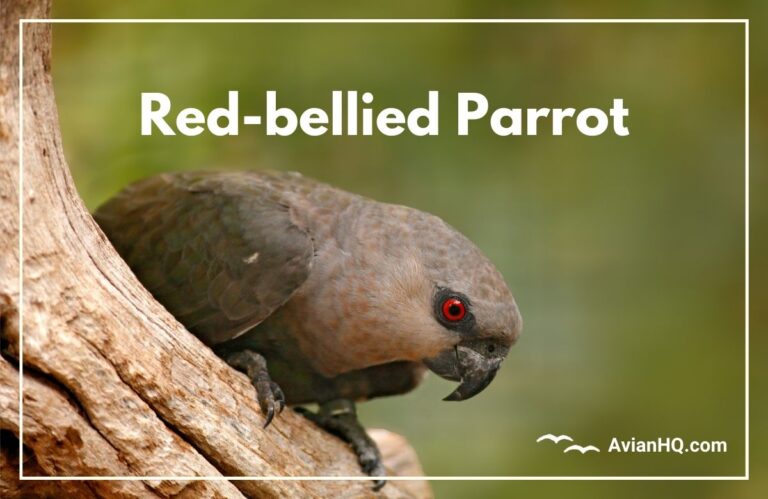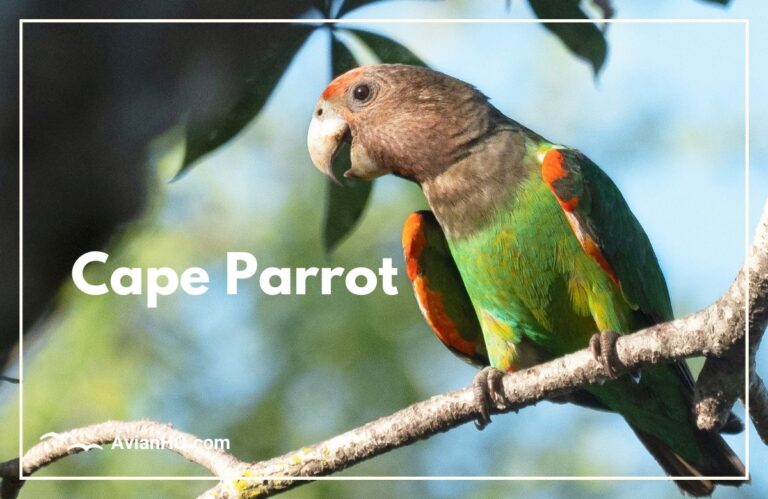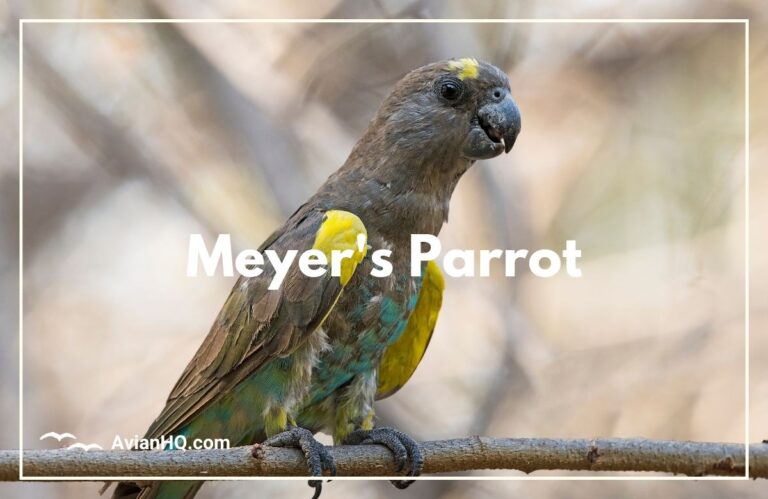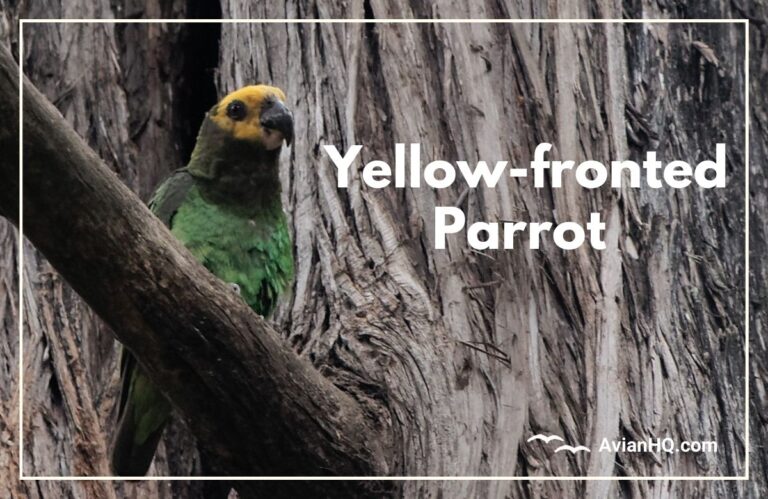Brown-necked Parrot or Uncape Parrot (Poicephalus fuscicollis)
The brown-necked parrot is a beautiful medium-sized African parrot that stands out with it’s striking colors and stocky build. When you first glimpse this bird with it’s vibrant green wings and back, greyish head and neck, and bright red patches under the wings, you can’t help but do a double take.
With an average length of 30-36 centimeters (12-14 inches) and weight ranging from 310-400 grams (11-14 ounces), the brown-necked parrot has a relatively large head and thick bill suited for cracking hard nuts and seeds. This hardy bird makes it’s home in the savannas and woodlands of sub-Saharan Africa.
“The brown-necked parrot is sometimes called the ‘uncape parrot’ to distinguish it from a close relative, the Cape parrot.”
The brown-necked parrot actually consists of two distinct subspecies with some key physical differences. The savanna-dwelling nominate subspecies, P. fuscicollis fuscicollis, has a brownish-grey neck while the P. fuscicollis suahelicus subspecies has more silver-toned head and neck plumage.
These medium-sized parrots may not be the flashiest, but their vibrant colors and personalities make them popular companion birds. Their high intelligence and ability to mimic speech have also earned them a dedicated following amongst aviculturalists and pet owners.
This article will cover everything you need to know about the natural history, physical description, distribution, diet and behavior of the magnificent brown-necked parrot. We’ll also look at some key factors in their conservation status and popularity in captivity. So read on to learn all about this stocky African parrot species.
History and Taxonomy
The regal brown-necked parrot has a taxonomic history spanning over 200 years since first being described by German naturalist Heinrich Kuhl in 1819. Kuhl named the new parrot species Poicephalus fuscicollis, with the species name coming from Latin words meaning “dark necked”.
“Though Kuhl was unsure which African country the type specimen was collected from, he knew it was a distinct species closely related to the Cape parrot.”
For decades, the brown-necked parrot was considered a subspecies of the Cape parrot (Poicephalus robustus), which inhabits South African montane forests. However, in 1997, ornithologist Phillip Clancey published research showing significant physical and habitat differences between the Cape parrot and savanna-dwelling P. fuscicollis. His work demonstrated these were two distinct species rather than subspecies.
Further genetic analysis in 2015 provided more evidence that the brown-necked parrot lineage split off from the Cape parrot 2.13-2.67 million years ago. This divergence coincided with shifts between forest and grassland dominance in Africa. Physical separation led to reproductive isolation and ultimately, speciation.
Today, the brown-necked parrot remains classified as a distinct species with two recognized subspecies:
- P. f. fuscicollis – The nominate subspecies with a brownish-gray neck and bluer plumage, native to west Africa
- P. f. suahelicus – East African race with silver-tinged head and greener undersides
The old habit of calling P. fuscicollis the “uncape parrot” stems from it being the more common species found in captivity prior to the taxonomic split.
Physical Appearance
The brown-necked parrot is a relatively large Poicephalus parrot with a stocky build yet athletic look. As the biggest species in it’s genus, it measures an impressive 30-36 centimeters (12-14 inches) long on average. These sturdy birds typically weigh between 310-400 grams (11-14 ounces).
“The brown-necked parrot has a large bill suited for cracking hard nuts and seeds, a key part of it’s natural diet.”
The nominate race (P. f. fuscicollis) has vivid yellow-green upper plumage along with a brownish-gray neck and head. It also has a bluer sheen overall compared to the segundo subspecies. Meanwhile, the P. f. suahelicus subspecies native to east Africa has more silver-toned head feathers and a greener underside.
Both subspecies have a mostly green body and wings, with vibrant red patches visible under the wings and at the thighs when in flight. The short wide tail feathers are typically blackish-brown. The eyes are dark brown and encircled by a prominent bare white or gray eye ring. And like most parrots, the bill is curved and horn-colored.
One handy identification tip – adult female brown-necked parrots have an orange band across the forehead that males lack. So this simple crown marking signifies gender in thisAfrican parrot.
Stay tuned to learn more about the habitat range, behavior and conservation outlook for this eye-catching parrot.
Habitat and Distribution
The brown-necked parrot inhabits a wide swath of sub-Saharan Africa, residing in savanna and dry open woodland habitats. This species is well adapted to warm, arid environments compared to forest-dwelling relatives like the Cape parrot.
The P. f. fuscicollis subspecies, with it’s brownish-gray neck, ranges across west Africa from Senegal and Gambia eastwards to Ghana and Togo. These birds can be locally common, though populations in Senegal and Gambia seem to be declining.
Meanwhile, the grey-necked east African race P. f. suahelicus is found from Tanzania and Congo southwards to northern Namibia and South Africa. This subspecies roams widely across southern Africa, occurring in southeastern Democratic Republic of Congo, Rwanda, Burundi, Tanzania, Zambia, Malawi, Mozambique, Zimbabwe and northeastern South Africa. It’s range also extends into southern Angola.
Both brown-necked parrot subspecies mainly reside in lowlands up to 1,300 meters (4,200 feet) elevation. But during seasonal movements, some individuals may range as high as 1,800 meters (5,700 feet).
These parrots occupy savannas dominated by acacia and broad-leafed woodland, preferring areas interspersed with meadows and grasslands. The brown-necked parrot is well adapted to warm, periodically dry conditions compared to relatives inhabiting temperate forests.
Diet and Feeding
The sturdy beak of the brown-necked parrot is a specialized tool for accessing nutritious seeds and nuts. This medium-sized parrot uses it’s thick bill to open hard-shelled foods other birds can’t crack.
In the wild, the brown-necked parrot feeds on a wide variety of native vegetation. It’s main natural foods are seeds, nuts, pods, and fruits gathered from trees, shrubs and vines native to African savanna and woodlands.
Some documented food plants utilized include acacia, terminalia, combretum, ziziphus, bolus, ximenia and other genera. The parrots have also been observed consuming introduced eucalyptus seeds in Africa.
This parrot employs a couple different techniques to open tough, woody capsules and access the oil-rich nuts. Sometimes they deftly pick out and discard husks to reach the seed kernel hidden inside. Other times, they use their strong bill to methodically crush or shred the exterior coating.
“Observers describe watching flocks of brown-necked parrots noisily gathering and feeding with nutshell shards littering the ground below.”
In the early dry season when little fresh food or free standing water may be available inland, some flocks temporarily move closer to major rivers. But these adaptable parrots can utilize many drought-tolerant food sources to survive harsh conditions. Clearly this African parrot is well equipped for exploiting seasonal savanna vegetation.
Breeding and Reproduction
The brown-necked parrot nests in natural tree holes and woodpecker nest cavities found amid open savanna woodlands. Though not migratory, wild pairs may wander widely outside the breeding seasons in search of ample food sources.
When the rainy period returns, mated pairs establish a nesting territory with suitable nesting sites. Brown-necked parrots show high fidelity to a particular nest location once they have successfully raised a clutch. Pairs typically reuse the same tree hollow each year.
“In captivity, breeding pairs also readily accept enclosed nest boxes lined with a layer of wood chips.”
The female typically lays 2-4 white eggs which are incubated by both parents for 28-30 days. Once hatched, the helpless chicks are fed regurgitated nuts and seeds by the parents. Young parrots leave the nest at 10-11 weeks old once they are fully fledged and able to feed themselves.
Wild brown-necked parrots only produce one brood per season. But captive breeding pairs may raise two or even three clutches annually. Providing proper nutrition and nest sites allows these parrots to successfully breed year after year in aviaries and breeding facilities.
“High reproduction rates combined with adaptable generalist food habits help explain the brown-necked parrot’s broad habitat range across Africa.”
Stay tuned to learn about more brown-necked parrot behaviors and why this species remains relatively common compared to other African parrots.
Behavior and Ecology
The brown-necked parrot resides in small to large flocks for most of the year, roaming savanna woodlands in search of seasonal food and water sources. Average flock size ranges widely from 5-300+ individuals, with smaller subgroups coming together in large communal roosts.
These highly social parrots display lively, gregarious behavior within flocks. Wild observers delight in their acrobatic antics like hanging upside down, causal wrestling, or passing nuts back and forth between members. Their playful interactions and curiosity lend well to habituation around humans.
Brown-necked parrots roost cavities in treetops overnight, choosing thorny acacias on the savanna edge to deter predators. Flocks break apart during the day, spreading out in smaller groups to search and forage for foods across a large territory. Their strong bills allow them to utilize diverse seasonal vegetation other bird species can’t access.
As generalist feeders able to exploit many native plants, brown-neck parrot populations can persist better than forest specialists during dry seasons or drought. This dietary flexibility, plus capacity to breed faster than rainforest parrots, likely contributes to the brown-neck’s wide habitat range and large populations today.
Yet habitat loss still poses threats for the future. Learn more about conservation efforts and outlook for this adaptable species next.
Conservation
The brown-necked parrot is currently evaluated as Least Concern on the IUCN Red List of Threatened Species. Experts judge this species has an extremely large natural range across over 20 African countries. Overall population sizes haven’t been quantified but are presumed large enough not to near the threshold for a threatened category.
However, habitat loss poses growing concerns for the future. Conversion of wooded grasslands for agriculture, overgrazing by livestock, and logging pressures have increased substantially across Africa over the past 30 years.
“Although brown-necked parrot populations currently remain widespread, their specialized habitat niche makes them vulnerable to land use changes.”
For instance, the subspecies in west Africa appears to be declining locally in Senegal and Gambia due to pressures on savanna ecosystems. The nominate race (P. f. fuscicollis) may warrants closer monitoring of any population decreases going forward.
Few Brown-necked parrots live in officially protected preserves as the species mainly resides in unprotected community land habitats. But this bird remains locally common enough not to trigger immediate conservation interventions.
“Habitat conservation efforts that protect stands of native vegetation will give the best long-term chance for sustaining brown-neck populations across their African range.”
Captivity and Cultural Significance
The brown-necked parrot’s charming personality and abilities have earned it popularity as an aviculture species and household pet. This bird adapts readily to cages and excels at learning tricks or even mimicking speech.
In captivity, brown-necked parrots have an average lifespan exceeding 20-25 years with proper care and diet. Their relatively large size and powerful beak mean they pack a harder bite than petite parakeets if ever provoked. But they rarely show aggressive behavior when habituated to human presence.
“The brown-necked parrot’s hardiness, longevity and trainable nature make it a fulfilling lifelong pet for experienced bird owners.”
In the wilds in Africa, local peoples have long incorporated this familiar savanna species into cultural lore and traditions. Some ethnic groups view the brown-neck parrot as a protective charm. It’s sociable nature around human settlements leads to a cultural affinity with people across much of it’s habitat range.
Unfortunately the brown-necked parrot’s trusting behavior also leaves wild populations vulnerable to trapping for the pet trade. Trade is primarily domestic but a small number of wild-caught birds are still smuggled to foreign markets. But most captive bloodlines today come from aviary-bred stock rather than illegal harvesting.
Ensuring sustainable captive breeding practices prevents added pressure on wild populations already facing habitat loss pressures in regions of Africa. Supporting aviculture conservation efforts allows enthusiasts to safely enjoy this charismatic parrot as a pet globally.
Conclusion
The brown-necked parrot may not have the flashiest plumage or greatest size, but it’s vibrant colors, stocky build and playful nature give this species undeniable charisma. As Africa’s most widespread Poicephalus parrot, able to survive in areas most rainforest species can’t, the hardy brown-necked parrot mesmerizes bird lovers worldwide.
While still reasonably secure in the wild today, habitat pressures pose increasing concerns for sustaining populations long term. Ongoing monitoring and additional protected savanna reserves will help conserve habitat for this uniquely adapted dry forest parrot.
Meanwhile, captive breeding continues to supply the global pet trade and aviculture hobby with a beautiful, personable African parrot. For experienced owners, the brown-necked parrot makes an intelligent, long-lived pet able to form close bonds with caretakers.
So if seeking an active mid-sized parrot that delights with it’s antics and charm, the brown-necked parrot deserves your consideration. Just be sure you can provide a large durable cage, extensive enrichment and steady diet to meet it’s needs. In return, this beauty of the African bush may steal your heart for years to come!







